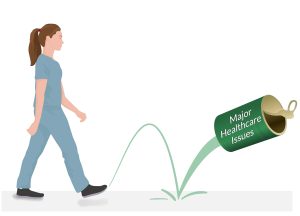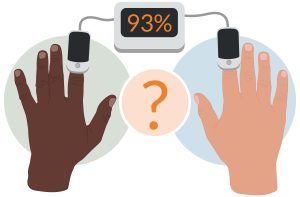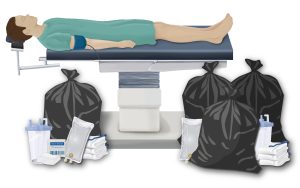Long before electronic amusements, ‘kick the can’ was a backyard game, representing a hybrid of hide-and-seek, but it disappeared in the 1960s. The phrase was reimagined in the late-70s by the media to ‘kick the can down the road,’ reflecting our government neglecting attention to important issues, putting off the needed resolution. As part of the community of anesthesia providers, we are collectively guilty of kicking the can down the road on many challenges in healthcare, all with public health implications.
We’ve chosen to illustrate two ‘cans’ focusing on the topics of bias in healthcare and healthcare waste, that the current and previous generations of providers have failed to stop, pick up, and properly deal with.

|Table of Contents
- Can #1: The Pulse Oximeter (POX)
- A Call to Action: The Pulse Oximeter Bias
- Can #2: Our Perioperative Byproducts
- A Call to Action: Reducing Our Carbon Footprint
- Final Thoughts
Can #1: racial bias with the pulse oximeter (POX)
The assessment of hemoglobin saturation with O₂ (SpO₂) critically determines our clinical decision-making. We widely use it throughout health care and consider it a monitoring standard during anesthesia. We commonly perform this at the bedside with a POX, a device with a design flaw known for over 30 years. Patients with darker skin, compared to those with lighter skin, are disadvantaged in that they have a greater likelihood of experiencing occult hypoxemia.
Despite many studies and clinical observations demonstrating the flaw, it was not until the COVID-19 pandemic that the issue became publicly apparent and widely reported in peer-reviewed and lay publications. Professional societies, policymakers, scientists, and the public are now acutely aware of the problem.
Given the extent of the pandemic, high-quality prospective and retrospective datasets are now available to address important clinical questions. A recent example in over 10,000 patients demonstrated POX measurement bias that disadvantaged dark-skinned patients, causing significant, in some cases, catastrophic delays in their eligibility for COVID-19 treatment.
The SpO₂ in Black and Hispanic COVID-19 patients read 92%-96% when in actuality, a high rate of lab arterial samples (SaO₂) simultaneously taken were < 88%. This resulted in ineligibility for treatment based on guidelines established by professional agencies for the use of steroids, remdesivir, paxlovid, and tocilizumab.

It has long been appreciated that racial and ethnic minorities are at a disadvantage in specific clinically important measurements, ones less obvious than oximetry. While there are many of these, two examples are race- and ethnicity-based clinical norms for pulmonary function studies and glomerular filtration fraction tests. Their interpretation is based on non-minority standards known to underestimate the extent of lung and kidney disease in minorities, resulting in undertreatment and treatment delays.
Another example is the peripartum death and complication rate in blacks compared to whites, securing the U.S. firmly in last place among all developed nations. The discrepancy is growing, not shrinking.
A call to action: ending racial bias in healthcare
Why has the flaw in accuracy in certain patients not been acted upon, and how should we, as clinicians respond? There are many reasons for the former and opportunities for the latter.
Predominantly and in many cases, the sole use of whites in trials of oximetry established norms biased towards an exclusive ethnicity. The economics are considerable in replacing existing devices or developing new ones. And then there is the passiveness of healthcare education—its slowness in reacting to new information. For now, we should act as activists and strongly urge that our next-generation devices work equivalently in all patients. Resistance is likely as it will be an entirely market-driven enterprise. The key may be to work to ensure regulatory scrutiny by directly lobbying our legislators.
We rely on SpO₂ as a noninvasive mirror of SaO₂. Pretty important stuff! If we need to rely more on invasive tests, increased cost and the possibility of complications are likely consequences.
We should not be asked to use, or be held hostage to using, a device that does not work well in certain patients. Until action catches up with the need, maintain a high index of suspicion. But let’s not kick this can down the road any further.
Can #2: our clinical and healthcare waste
There is a pressing need for aggressive and sustained reduction in the amount of CO₂ and other gases acting as a blanket, decreasing radiant heat loss from the planet. Greenhouse gas emissions come from various sources, but we conveniently overlook healthcare’s contribution to the carbon footprint —we continue to kick the can down the road.
What about CRNAs? Do we contribute to the carbon footprint? Several international societies representing our specialty recently developed guidelines and recommendations regarding waste anesthetic gases. The halogenated ethers and N₂O we use are potent greenhouse gases. Estimates place these as accounting for 3-5% of the climate footprint. Are there other perioperative contributions we play a role in?

The Dutch artist, M Koijck, creates art from discarded materials and photographs them. Check out her video. It is a stunning aerial view of Koijck lying on the floor surrounded, in concentric circles, by the perioperative disposables, including our throwaways, associated with her surgery. The impression is one of voluminous waste amplified by knowing that 50,000,000 surgeries are performed yearly in the U.S. alone.
In a recent, sophisticated study examining the carbon footprint of knee arthroplasty, the authors identify key areas where CRNA-rendered care has an impact. Inhalational gases, single-use disposable, fresh gas flow, and electricity use are all proven contributors.
A call to action: reducing our carbon footprint in healthcare
You are likely wondering, “Is there anything I can do?” There are things we can do, and if the change occurs on a wide enough scale—that is, no longer kicking the can down the road—the results can be substantial.
For example, using low fresh gas flows, total intravenous anesthesia, and regional anesthesia, when appropriate, can have a meaningful impact. Regardless of technique, mindfulness regarding possible shifts from single-use to reusable items can make a substantial difference.
One example is that for all cleaning scenarios, a reusable BP cuff is environmentally superior to a disposable cuff when regarding carbon contributions. We can recycle plastics and glass. We can also improve energy efficiency by having our OR leadership turn lights and air flow systems off in closed rooms, optimize case scheduling, set reasonable room temperatures, and only plug in essential devices.
Final thoughts on facing these challenges in healthcare
The POX may be Earth’s most widely used medical instrument besides the thermometer and BP cuff. Who could have imagined that a device built for aviation research in WW II would eventually find its way into the operating room? It relies on an “R calibration curve” based on norms associated with red and infrared light transmitted through tissues. Skin pigment can act as a variable light filter which can perturb R. Though we’ve long known this, the pandemic highlighted the need to appreciate and correct racial bias with the POX.
The U.S. healthcare sector contributes substantial amounts to the contamination of our environment, quantifiable in terms of its carbon footprint, one that ultimately impacts public health. Numerous studies, past and present, unequivocally demonstrate that, as clinicians, we have an imperative to reduce our carbon footprint.

Let’s no longer kick the can down the road and repeat the failings of our previous generation(s) of providers.
As CRNAs ourselves, we understand the challenge of fitting CRNA continuing education credits into your busy schedule. When you’re ready, we’re here to help.







